
Original Link: https://www.anandtech.com/show/2451
AMD's CrossFireX: Tri & Quad GPU Preview
by Anand Lal Shimpi on February 21, 2008 3:00 AM EST- Posted in
- GPUs
Back when we reviewed the Phenom AMD really wanted us to stress the importance of CrossFireX as a part of the overall platform package. After all, only AMD 790 FX motherboards were properly equipped to support four GPUs and that was a clear advantage Phenom held over Intel's Core 2. We see this sort of pressure all the time; NVIDIA has been trying to get us to test with its "platforms" for the past year, with little success of course.
We never capitulate, always stressing that we'll use components because they make sense, not because they are a part of some platform that doesn't necessarily offer a tangible benefit to the end user. We strive for scientifically sound comparisons at AnandTech, testing ATI video cards on an AMD platform and comparing them to NVIDIA video cards on an NVIDIA platform would violate the scientific method in a horribly inappropriate way.
It's always a good thing that we don't capitulate, but it was extra good in the case of Phenom for one very obvious reason: CrossFireX didn't work. Upon Phenom's launch, CrossFireX was promised as a feature but the driver support was not ready. Even today, CrossFireX continues to be a feature that's been promised but not delivered.
What is CrossFireX? The new CrossFire is AMD's attempt to finally achieve multi-GPU parity with NVIDIA's SLI. And like NVIDIA's SLI, CrossFireX supports configurations of 2, 3 or 4 GPUs.
All the way down to basic marketing CrossFire has always fallen short of dethroning SLI, but AMD has been making significant strides towards perfection. The release of the Radeon HD 3870 X2 surprised us, as it was the most seamless multi-GPU implementation we've ever seen. The card just...worked. AMD promised a new world of multi-GPU support in the future after the release of the X2, and since that review we've started giving it the benefit of the doubt.
AMD plans on enabling CrossFireX support sometime in March (we also plan on being at CeBIT sometime in March, maybe the two will coincide), but in the interim we've been provided with a preview system to begin to whet our quad-GPU appetites.
Receiving such a system doesn't come without its caveats however. The graphics and chipset guys over at AMD are a bit frustrated, they finally have a competitive GPU and they never get tested on their own platforms because everyone uses Intel CPUs. Had Phenom been competitive at launch this would be a very different situation, but it wasn't, so it's not.
In an effort to give Phenom some more limelight, AMD built these CrossFireX systems with 790 FX motherboards and quad-core Phenom CPUs running at 2.6GHz. We were only allowed to run today's tests on this platform. (Shh...we never capitulate!)
When testing four GPUs we tend to run at very high, GPU bound, resolutions making the choice of CPU much less of an issue. If anything, AMD was hurting itself by forcing Phenom upon us but it figured that any performance deficit due to CPU choice wouldn't be too great thanks to the GPU-limited nature of most of the tests we'd be running.
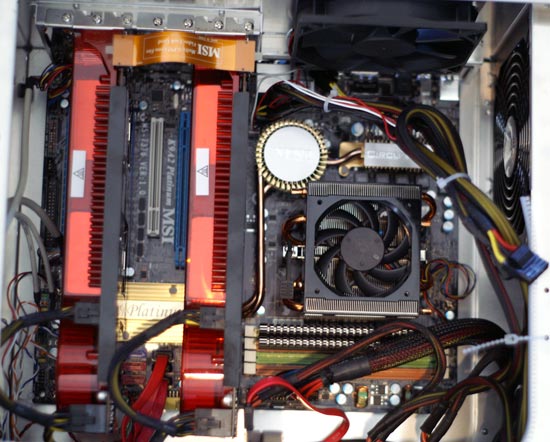
The system, all AMD
The other stipulation for receiving this preview system is that we had to agree to only test the games AMD shipped with the system: Call of Duty 4, Bioshock, Unreal Tournament 3, Crysis and Half Life 2: Episode Two. AMD's explanation for why is as follows:
"We’ve chosen some apps that demonstrate the performance that these new configurations afford gamers, and the scalability that can be seen when moving from a single GPU to four GPUs. While these apps show good scaling, we haven’t selected these because they represent the “best-case scenario” – in fact, there are other games that exhibit better scaling, as your testing down the road will show. The five apps we’ve chosen are intended to be a fair representation of the CrossFireX experience in general. "
Certainly when it comes time to actually review CrossFireX we'll be able to test on our own system with whatever games we'd like, but for this preview we were limited to the titles mentioned above. Thankfully the titles AMD allowed us to test with were all parts of our regular suite and we do believe that the intention wasn't to paint CrossFireX as best as possible, but to avoid this preview turning into a list of games that didn't work.
Given the constraints, you should view this article much as the title indicates - a preview.
The Drivers
Make no mistake, we are dealing with the earliest drivers AMD was willing to let out of its control - in other words we should expect bugs.
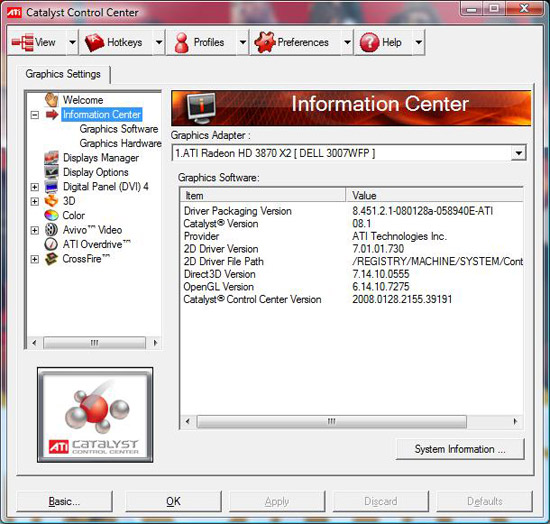
Much like our Radeon HD 3870 X2 experience, CrossFireX just worked. Switching between 2, 3 and 4 GPUs did require a driver reinstall for things to work perfectly but once we ticked that little CrossFire checkbox everything worked as it should.
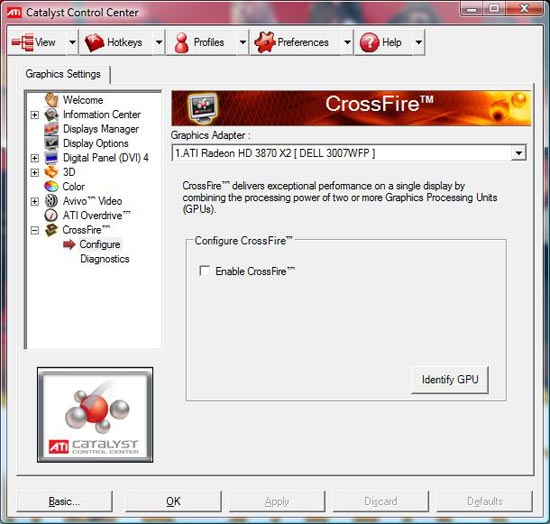
CrossFireX: Don't Feed After Midnight
The rules for CrossFireX are simple: you can make any combination of up to 4 RV670 based GPUs, using either Radeon HD 3850s, 3870s or 3870 X2s. Note that the upper limit is two Radeon HD 3870 X2 cards (4 GPUs).
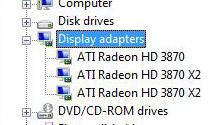
While the clock speeds aren't normalized to the slowest card in the arrangement, the faster cards will have to wait on slower cards so ideally you'd want to pair similarly clocked GPUs.

Two Radeon HD 3870 X2s in action

The Test
| Test Setup | |
| CPU | AMD Phenom @ 2.6GHz |
| Motherboard | MSI K9A2 Platinum |
| Video Cards | ATI Radeon HD 3870 X2 ATI Radeon HD 3870 |
| Video Drivers | Catalyst 8.1 (Modified for CrossFireX Support) |
| Hard Drive | Seagate 7200.9 300GB 8MB 7200RPM |
| RAM | 2x1GB Corsair XMS2 DDR2-800 4-4-4-12 |
| Operating System | Windows Vista Ultimate 64-bit |
We ran the following games in their corresponding quality settings:
| Game | Resolution | AA | AF | Detail Settings |
| Half Life 2: Episode Two | 2560 x 1600 | 8X | 16X | Highest in-game |
| Unreal Tournament 3 | 2560 x 1600 | 0X | 16X | Highest in-game |
| Bioshock | 2560 x 1600 | 0X | 1X | Highest in-game |
| Call of Duty 4 | 2560 x 1600 | 4X | 16X | Highest in-game |
| Crysis | 1920 x 1200 | 0X | 1X |
High Quality defaults |
The graph below shows the performance levels you can get from a single GPU all the way up to four:
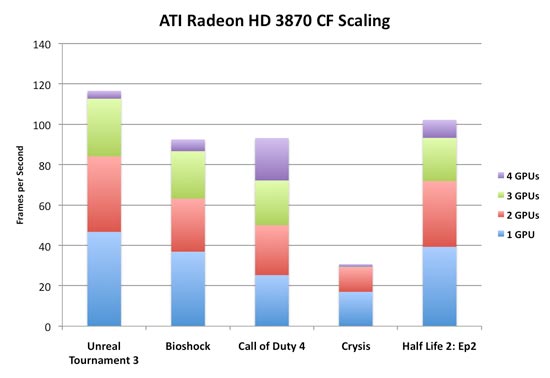
Obviously the biggest jump comes from one to two GPUs, but we still see some reasonable gains going from two to three. The value of a fourth GPU is simply nonexistent in most of the cases.
| Number of GPUs | HL2 | UT3 | Bioshock | CoD4 | Crysis |
| 1 x Radeon HD 3870 | 39.3 | 46.7 | 36.9 | 25.3 | 14.0 |
| 2 x Radeon HD 3870 (1 X2) | 71.9 | 84.1 | 63.2 | 50.0 | 26.2 |
| 3 x Radeon HD 3870 (2 X2 + 1) | 93.3 | 112.7 | 86.7 | 72.2 | 26.4 |
| 4 x Radeon HD 3870 (2 X2) | 102.2 | 114.6 | 92.5 | 93.2 | 27.7 |
Let's put some percentages with the graph above to put things into perspective:
| Configuration | HL2 | UT3 | Bioshock | CoD4 | Crysis |
| 2-way CF Improvement over 1 card | 83% | 80% | 71% | 98% | 87% |
| 3-way CF improvement over 2 cards | 30% | 34% | 37% | 44% | 0% |
| 4-way CF improvement over 3 cards | 10% | 3% | 7% | 29% | 4% |
| 4-way CF improvement over 1 card | 160% | 150% | 151% | 268% | 98% |
The move from one to two cards generally yields a healthy performance improvement, but the gains taper off as we look at the performance added by a third GPU. Call of Duty 4 is the only game that shows solid gains with 4 GPUs (29% over a 3-GPU configuration), the rest of the titles show mostly single-digit percentage improvements. Once again we see that Crysis simply needs new, faster GPU architectures - four GPUs does absolutely nothing for this game.
Remember our 3-way SLI review from earlier in the year? Although the test systems were very different, the GPU-bound scaling should be comparable (if anything, NVIDIA should have the advantage of being run on an Intel system). Here's a quick look back at some of the comparable benchmarks:
| Configuration | UT3 | CoD4 |
| 2-way SLI Improvement over 1 card | 84% | 90% |
| 3-way SLI improvement over 2 cards | 20% | 28% |
| 3-way SLI improvement over 1 card | 121% | 143% |
Single to dual GPU scaling is similar with SLI as CrossFire, but the 2-way to 3-way gain is better on CrossFireX. NVIDIA's quad-SLI is not yet available so we're not sure how the 4-way scaling will compare, but so far it seems like CrossFireX is doing quite well in the pure numbers game.
Power Consumption
In our 3-way SLI review we saw power consumption figures close to 800W at the wall outlet, thankfully with cooler running GPUs the CrossFireX numbers aren't as bad:
| Number of GPUs | Idle Power | Load Power (Bioshock) |
| 1 x Radeon HD 3870 | 148W | 257W |
| 2 x Radeon HD 3870 (1 X2) | 181W | 361W |
| 3 x Radeon HD 3870 (2 X2 + 1) | 211W | 406W |
| 4 x Radeon HD 3870 (2 X2) | 240W | 538W |
With four GPUs we're over 500W of power consumption at the wall when running our Bioshock benchmark. There's still no clear need for greater than 1kW power supplies, but the better-safe-than-sorry mentality appears to be in full effect.
Final Words
We have to give AMD credit, there was no cherry picking of titles for this preview - for the most part, the benchmarks AMD itself selected showed no real need for 4-way CrossFireX over 3-way. We do appreciate the honesty, but it's clear that the world just isn't ready for a quad-GPU solution.
Due to the state of AMD's driver optimizations DX10 games currently only scale well to 3 GPUs and not much beyond (Crysis/Bioshock), while DX9 games will generally scale better all the way up to 4 GPUs. We expected the opposite to be true but AMD provided us with technical insight as to why it is the case:
"The biggest issue is DX10 has a lot more opportunities for persistent resources (resources rendered or updated in one frame and then read in subsequent frames). In DX9 we only had to handle texture render targets, which we have a good handle on in the DX10 driver. In addition to texture render targets DX10 allows an application to render to IBs and VBs using stream out from the GS or as a traditional render target. An application can also update any resource with a copy blt operation, but in DX9 copy blt operations were restricted to offscreen plains and render targets. This additional flexibility makes it harder to maximize performance without impacting quality.
Another area that creates issues is constant buffers, which is new for DX10. Some applications update dynamic constant buffers every frame while other apps update them less frequently. So again we have to find the right balance that generally works for quality without impacting performance.
We are also seeing new software bottlenecks in DX10 that we continue to work through. These software bottlenecks are sometimes caused by interactions with the OS and the Vista driver model that did not exist for DX9, most likely due to the limited feature set. Software bottlenecks impact our multi-GPU performance more than single GPU and can be a contributing factor to limited scaling.
We’re continuing to push hard to find the right solution to each challenge and boost performance and scalability wherever we can. As you can see, there are a lot of things that factor in."
From AMD's explanation it sounds like there's still a lot of work to be done on the CrossFireX driver. While we can expect to see its public debut in March, it seems like it'll be a while before we're anywhere close to ideal scaling. We've found ourselves in this position with many-GPU designs in the past, at least the players are taking things a bit more seriously this time around.







